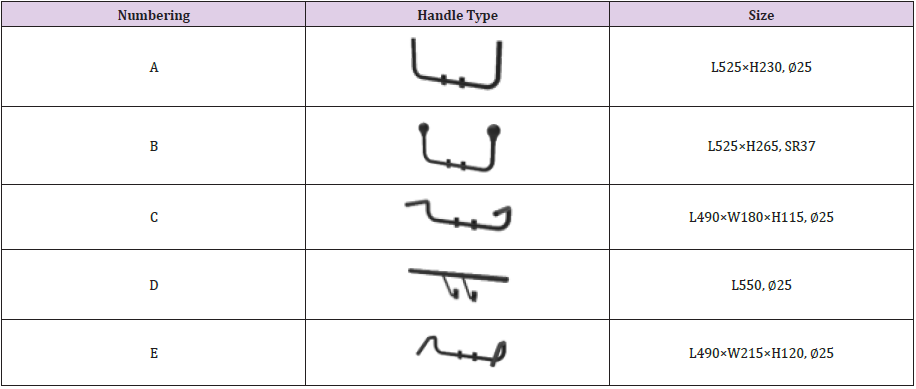EXTENDED ABSTRACT
Research Purpose
Ambulance crew in hospital should use different types of handles when an accident
happens, such as clinical cart and hospital bed. They should change the itinerary
constantly when passing through the limited space [1]. An investigation pointed that
upper limb muscle discomfort of prevalence rate is 82.8%. For patient severity, both
wrists (26.1%) and hands (25.2%) were even higher than shoulder (3.1%) and neck
(2.6%). The result shows short-staffed since hospital transmission and rule. Moreover,
Lift and limb muscle discomfort were directly related. Cumulative trauma on wrist arises
from traction angle [2].
This study is to different of the wrist angle by using types of handles in the crash cart.
a) Effects of carpal joint variation on participants in different of the wrist angle.
b) Effects of carpal joint variation on participants in different of the direction of
exertion.
c) Effects of carpal joint variation on participants in different of the path.
d) Analysis the data and advise the best way to for relative crew.
Keywords:Handle; Crash Cart; Ulnar Deviation; Radial Deviation
Methods
Study participants carpal joint variation when the operating crash cart in different handle angle. Students at Ming Chi University of Technology were recruited to participate in the experiment. Ten healthy female college students are all right-handed. In 5 different handle angle of nursing cart, they should simulate nursing team on the direction of exertion (DOE) (pushing, pulling), path (walking in a straight line and turning left). There are 200 factors for carpal joint data in the experiment (2 DOE * 2 paths * 10 participants * 5 handles). All Data of carpal joint variation were processed and analyzed with the SPSS system; significant level (α) is 0.05. ANOVA is conducted to analyze and evaluate the effects of carpal joint variation between different DOE, path and handle angle. Moreover, participants were regarded as a block. The post-hoc test was performed according to ANOVA, and the analysis was performed by Duncan. The research recommends that wris0t extension <30°, flexion <45°, radial deviation and ulnar deviation <18° [3]. User may vulnerable when exceed the degree.
Materials
a. Crash Cart: The crash cart (DN05LX0Q) in the experiment
was produced by Chang Gung Medical Technology Co., Ltd.
(length x width x depth: 690 x 480 x 1500 mm). Loading weight
is 40kg, 15kg regulus lead puts discretely in drawer to simulate
infusion and tools. 25kg regulus lead put on cart to simulate
electric shock facility.
b. Handle: The study selects 5 different handles to
experiment according to references and cart handle saw on the
market (as shown in Table 1). References recommend that the
handle should install 95cm above the ground [4].
c. Path: There are two paths, walking in a straight-line
and turning left. Two paths will experiment separately. The
straight-line width of the path was 120cm, and the length was
400cm. Plan for turning left was go straight 200cm and turn left
90 degrees, then go straight 200cm again.
d. Goniometers: Goniometers for carpal joint in the
experiment was produced by Biometrics Ltd.
Goniometers will attach to participant dominant hand and
measure.
Results
Analysis of variance results shows that the effects of different handles are insignificant to participant on extension, radial deviation and ulnar deviation(p<0.001). Path of ulnar deviation(p<0.05), and DOE on extension and radial deviation(p<0.01). In addition, extension has interaction between handle and DOE, and also interacts between path and DOE. Radial deviation has interaction between handle and path, and also interact between handle and DOE. Analysis of Duncan shows that clustering of degree between handle B and handle E are the same. More safer for joint when operating other handles. Besides, ulnar deviation of turn left for turn left is higher than go straight. At last, the average angle of extension and radial deviation on pushing of the carpal joint is higher than pulling. All average angles also within the range that reference recommends.
Conclusion
At first, operators should use post-tension when using clinical cart. Secondly, transmission should diminish turn left path on the workplace. Finally, take handle B and E as a design reference on clinical cart in order to lower injury rate on musculoskeletal.
Acknowledgment
The authors would like to express appreciation for the support of the Ministry of Science and Technology (MOST) [Project Number = MOST 108-2314-B-131- 001-].
References
- Wiggermann N (2017) Effect of a powered drive on pushing and pulling forces when transporting bariatric hospital beds. Applied ergonomics 58: 59-65.
- Sheng Yao L (2017) A Survey of Work-related Upper Extremity Musculoskeletal Disorders Among Hospital Employees (Master Thesis). Retrieved from National Digital Library of Theses and Dissertations in Taiwan. (System Number 105CJU01590002).
- Stetson DS, Keyserling W M, Silverstein B A, Leonard JA (1991) Observational analysis of the hand and wrist: a pilot study. Applied Occupational and Environmental Hygiene 6(11): 927-935.
- Cheng Ping C, Zhi Yong C, Chi Yuang Y (2008) Renew of Existing Indigoes Anthropometric Database and Its Application in Establishing an Atlas for Workplace (III)(ISBN986-00-4805-3). Taipei County Institute of Labor, Occupational Safety and Health.

 Mini Review
Mini Review
